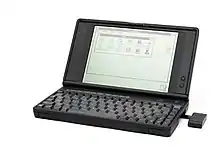HP OmniBook
HP OmniBook was a range of laptop personal computers created by Hewlett-Packard, introduced in 1993. The range was discontinued following the acquisition of Compaq by Hewlett-Packard in 2002, with the Compaq Presario, HP Compaq, and HP Pavilion laptops succeeding the OmniBook line.
 HP Omnibook 6100 | |
| Developer | Hewlett-Packard |
|---|---|
| Type | Notebook |
| Release date | 1993 |
| Discontinued | 2002 |
| Successor | HP Compaq, Compaq Presario, HP Pavilion |
Models

- OmniBook 300 (F1030A/F1031A/F1032A)
- OmniBook 425 (F1033A/F1034A/F1036A)
- OmniBook 430 (F1035A/F1037A/F1038A)[1]
- OmniBook 500
- OmniBook 510
- OmniBook 530
- OmniBook 600
- OmniBook 800
- OmniBook 900
- OmniBook 2000
- OmniBook 2100
- OmniBook 3000
- OmniBook 4000
- OmniBook 4150
- OmniBook 4400
- OmniBook 4500
- OmniBook 5000
- OmniBook 5500
- OmniBook 5700
- OmniBook 6000
- OmniBook 6100
- OmniBook 6200
- OmniBook 7000
- OmniBook 7100
- OmniBook XE2
- OmniBook XE3
OmniBook 300

The HP OmniBook 300 (OB300) is a "superportable" laptop released in 1993 as one of the first notebook computers in the OmniBook line. It weighed only 2.9 pounds and measured 1.4 × 6.4 × 11.1 inches. It is powered by an Intel 386SXLV processor, featured a full-size keyboard, a pop-up mouse (The same pop-up mouse was also used in Omnibook 800CT), and a 9-inch VGA screen.[2][3][4] Due to storage limitations, the OmniBook 300 included both Microsoft Excel and Microsoft Word pre-installed in ROM, which was and still remains unusual to this day.[5] It had two PCMCIA slots for additional memory, modem, network cards or other peripherals. One of its outstanding features was a technology known as "Instant On". It was sold in three storage configurations: no mass storage (F1030A at US$1,515), 10MB flash memory disk (F1031A at US$2,375), or 40MB hard drive (F1032A at US$1,950). Compared to the hard drive, the flash memory disk reduced the weight and storage capacity but increased battery life. It came with slimmed-down copies of MS-DOS 5.0 and Windows 3.1. The "International English" version of the OmniBook 300 used code page 850 (rather than the more common code page 437) as hardware code page.
See also
References
- "Windows 3.1 arbeitet auch im Enhanced Mode Hewlett-Packard erweitert die Festplatte der Omnibook-PCs". www.computerwoche.de (in German). Retrieved 2020-12-08.
- "HP Virtual Museum: Hewlett-Packard OmniBook 300, 1993". Hewlett-Packard. Retrieved 2012-02-20.
- "The OmniBook 600: Cute but Quirky". Cs.hmc.edu. Retrieved 2012-02-20.
- "Hardware". The HP Palmtop Paper. Thaddeus Computing. Retrieved 2012-02-20.
- "HP Computer Museum". Hpmuseum.net. Retrieved 2012-02-20.
External links
- Official HP pages
- OmniBook search results on HP's website
- OmniBook support page, with more extensive list of models here
- Others
- HP Omnibook Information Archived 2008-09-20 at the Wayback Machine - by Kieran Garbutt
- HP Omnibook site by Sean McCreary
